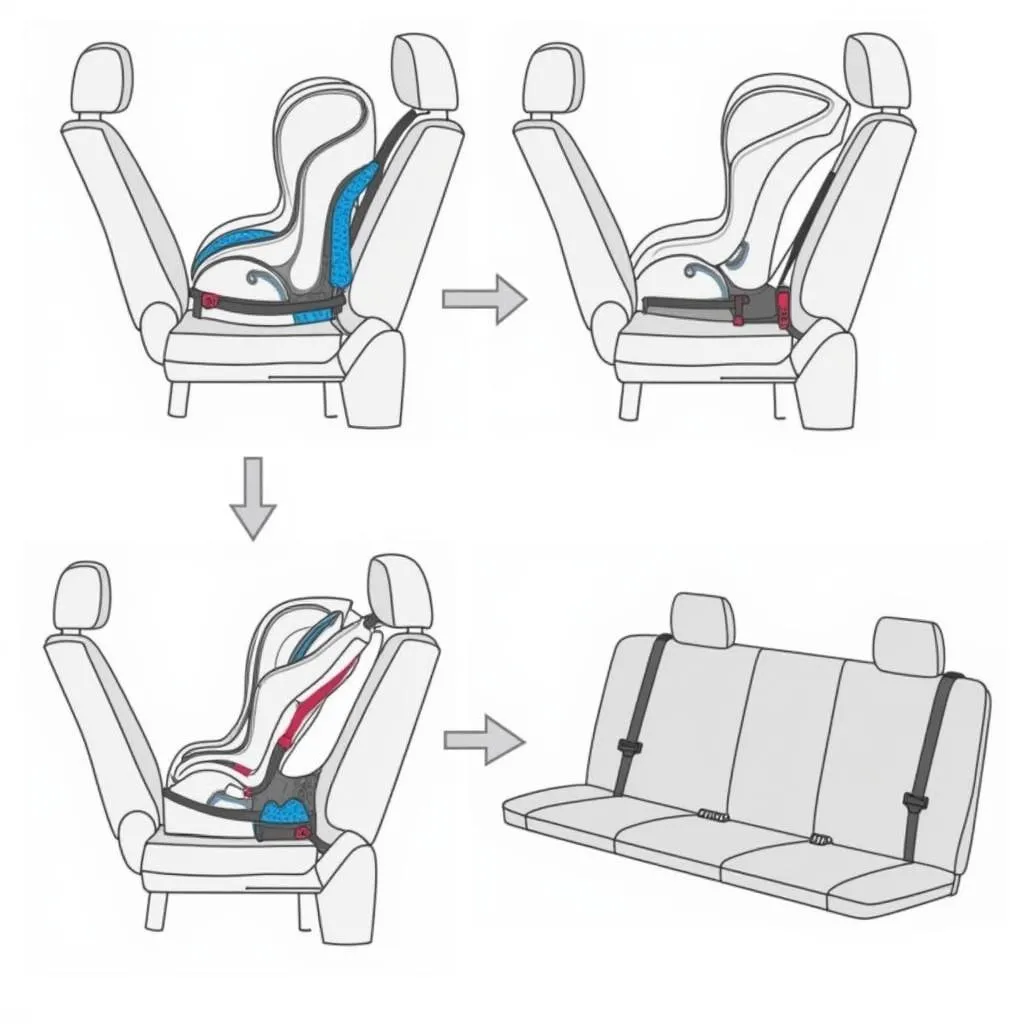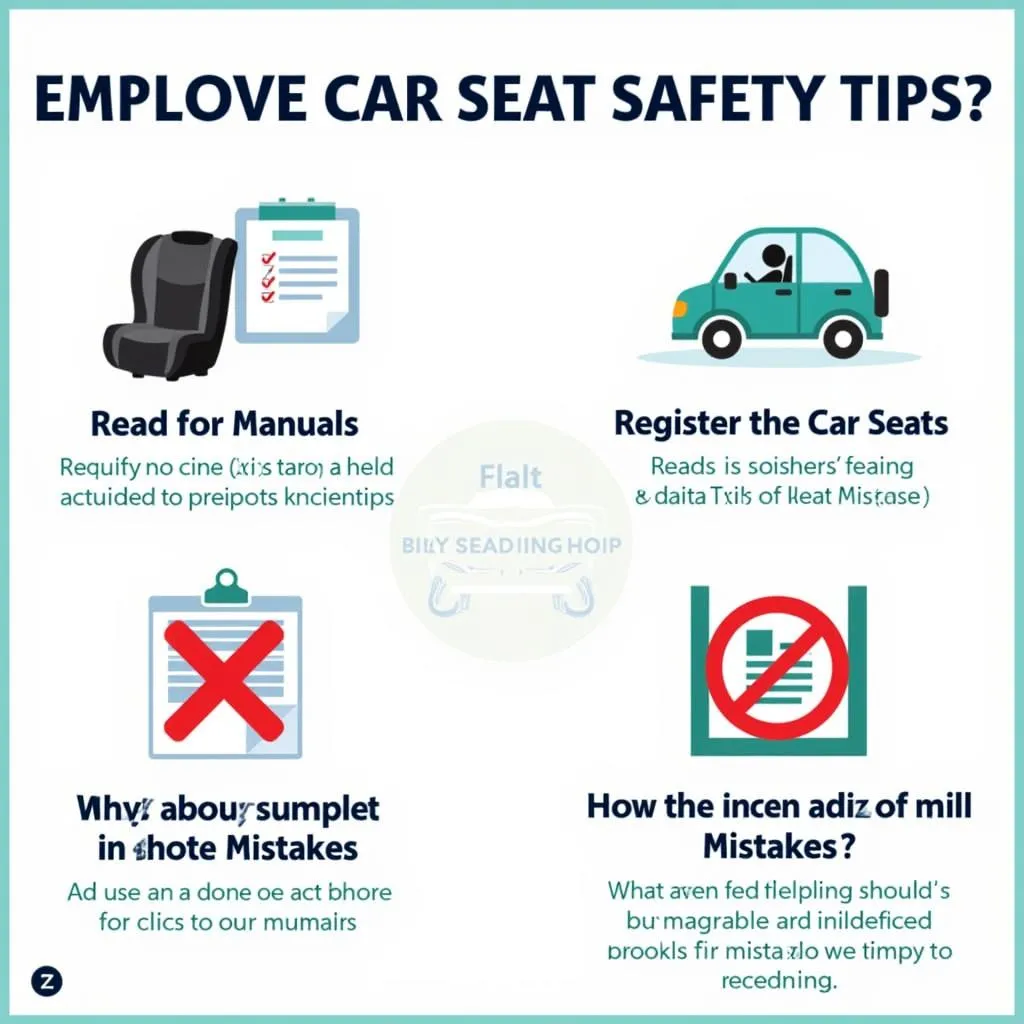Car Seat First Safety: Your Complete Guide to Keeping Your Child Safe
Car Seat First Safety is non-negotiable when it comes to protecting your most precious cargo. Choosing the right car seat, installing it correctly, and knowing how to use it properly are crucial steps in ensuring your child’s safety on every journey. This comprehensive guide provides everything you need to know about car seat first safety, from understanding different types of car seats to common mistakes to avoid.
 Choosing the Right Car Seat
Choosing the Right Car Seat
Understanding Car Seat Types
Before delving into installation and usage, it’s essential to select the right type of car seat for your child’s age, weight, and height.
Infant Car Seats
Designed for newborns and infants, these rear-facing seats offer the highest level of protection for a baby’s delicate neck and spine. Look for seats with a 5-point harness system and adjustable base for a secure fit.
Convertible Car Seats
As the name suggests, convertible car seats “convert” to accommodate a growing child. They can be used in both rear-facing and forward-facing positions, offering flexibility and value for money.
Booster Seats
When your child outgrows the forward-facing harness height or weight limit of their convertible seat, it’s time to transition to a booster seat. Boosters raise the child’s seating position to ensure the vehicle’s seat belt fits correctly across the stronger chest and hip bones.
 Installing a Car Seat Correctly
Installing a Car Seat Correctly
Car Seat Installation: A Step-by-Step Guide
Proper installation is paramount to maximizing your child’s safety. Follow these steps to ensure a secure fit:
-
Consult your vehicle and car seat manuals. Every car seat and vehicle is different, so always refer to the manufacturer’s instructions for specific guidance.
-
Choose the right location. Most car seats can be installed using either the LATCH system or your vehicle’s seat belt. Select the method that provides the most secure fit in your car.
-
Level the seat. Use the level indicator on the car seat to ensure it’s installed at the correct angle.
-
Tighten the straps. Whether you’re using the LATCH system or the vehicle seat belt, ensure the straps are tight enough that you can’t move the car seat more than one inch at the belt path.
-
Check the harness. Adjust the harness straps to fit snugly over your child’s shoulders and hips.
Common Car Seat Mistakes and How to Avoid Them
Even with the best intentions, parents and caregivers can make mistakes when it comes to car seat safety. Here are some common errors to avoid:
-
Turning forward-facing too soon. Keep your child rear-facing for as long as possible, ideally until they reach the maximum height or weight limit allowed by their car seat manufacturer.
-
Loose harness straps. The harness should be snug enough that you cannot pinch any slack at your child’s shoulder.
-
Incorrect seat belt placement. Ensure the seat belt is routed through the correct slots on the booster seat and lies flat across your child’s collarbone and hips.
-
Using expired or recalled car seats. Check the expiration date on your car seat and register it with the manufacturer to receive recall notifications.
 Essential Car Seat Safety Tips
Essential Car Seat Safety Tips
Car Seat First Safety: Beyond the Basics
In addition to the fundamentals, consider these additional tips to enhance your child’s safety:
-
Dress your child appropriately. Avoid bulky clothing or coats under the harness as they can compress in a crash, creating dangerous slack.
-
Never leave your child unattended in a car. Temperatures inside a parked car can soar rapidly, putting children at risk for heatstroke.
-
Lead by example. Always wear your seat belt correctly to instill safe habits in your child.
Conclusion
Car seat first safety is a continuous journey that evolves alongside your child’s growth. By staying informed, following manufacturer guidelines, and prioritizing safety on every trip, you can provide your little one with the protection they deserve. Remember, a [3 in 1 car seat safety first] approach is essential.
FAQs
1. How do I know if my car seat is installed correctly?
A correctly installed car seat should not move more than one inch at the belt path when you shake it at the base. Refer to your car seat and vehicle manuals for specific installation instructions.
2. When can my child switch to a booster seat?
Children can transition to a booster seat when they exceed the height or weight limit for the forward-facing harness in their convertible car seat.
3. How long are car seats good for?
Car seats have expiration dates, typically ranging from 6 to 8 years after their manufacture date. Check the label on your car seat for the specific expiration date.
4. Can I use a used car seat?
It is generally not recommended to use a used car seat unless you are certain of its history and it has never been involved in a crash.
5. What should I do if my car seat has been in an accident?
Even if the damage is not visible, it’s crucial to replace a car seat that has been involved in a moderate or severe crash.
Need help with your [safety first 3 and 1 car seat]? Our team of car experts is ready to assist you. Contact us via WhatsApp at +1(641)206-8880, email us at [email protected], or visit us at 276 Reock St, City of Orange, NJ 07050, United States. We offer 24/7 customer support.
For more insights on child passenger safety and related topics, explore our articles on [car essentials for baby] and learn about the importance of reliable vehicles like [Rockwell cars] or consider exploring options for pre-owned vehicles with reputable dealerships like [Dimmitt used cars].
